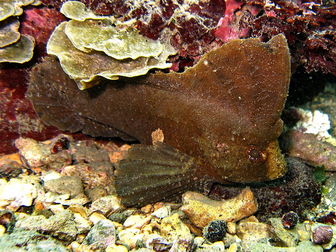Cockatoo waspfish

Original source: "Own work". Author "Vincent C. Chen is a Taiwanese recreational diver and free diver who dedicate to underwater photography and the marine lives protection. He is also one of the contributors to EZDive magazine since 2008."
Author: "Vincent C. Chen is a Taiwanese recreational diver and free diver who dedicate to underwater photography and the marine lives protection. He is also one of the contributors to EZDive magazine since 2008."
Permission: GNU Free Documentation License
The Cockatoo waspfish lives in the reef-associated, marine environment.
The Cockatoo Waspfish is usually observed at dusk and on night dives as they stay hidden during daylight hours.They are usually observed on sand in the vacinity of rocky reefs and sea grass beds feeding on small shrimps and other crustaceans. More
Cockatoo waspfishes tend to be more active at dusk or night. As is seen in some other scorpaenoids, this species often is found rocking back and forth in response to the surge, to mimic the seaweed that surrounds it. This species is quite venomous. More
Common names
Cockatoo fish in English
Cockatoo leaf-fish in English
Cockatoo waspfish in English
Cuckatoo waspfish in English
Ikan sampah in Malay (bahasa Melayu)
Kakaduefisk in Danish (dansk)
Laffe de fond in Creole, French
Laffe de fond in Creoles and Pidgins, French
Leaf fish in English
Novu in Gela
Poisson-feuille Peau-Rouge in French (français)
redskin fish in English
Redskinfish in English
Rooihuidvis in Afrikaans
Roque fish in English
Rouge fish in English
Tsumajiro-okoze in Japanese (日本語)
whitenose scorpionfish in English
帆鰭鮋 in Mandarin Chinese
帆鳍鲉 in Mandarin Chinese
狮子鱼 in Mandarin Chinese
獅子魚 in Mandarin Chinese
紅帆鰭鮋 in Mandarin Chinese
红帆鳍鲉 in Mandarin Chinese
背带钝顶鲉 in Mandarin Chinese
背带长绒鲉 in Mandarin Chinese
背帶鈍頂鮋 in Mandarin Chinese
背帶長絨鮋 in Mandarin Chinese

Family : Tetrarogidae
Genus : Ablabys
Species : Ablabys taenianotus
Authority : Cuvier, 1829
